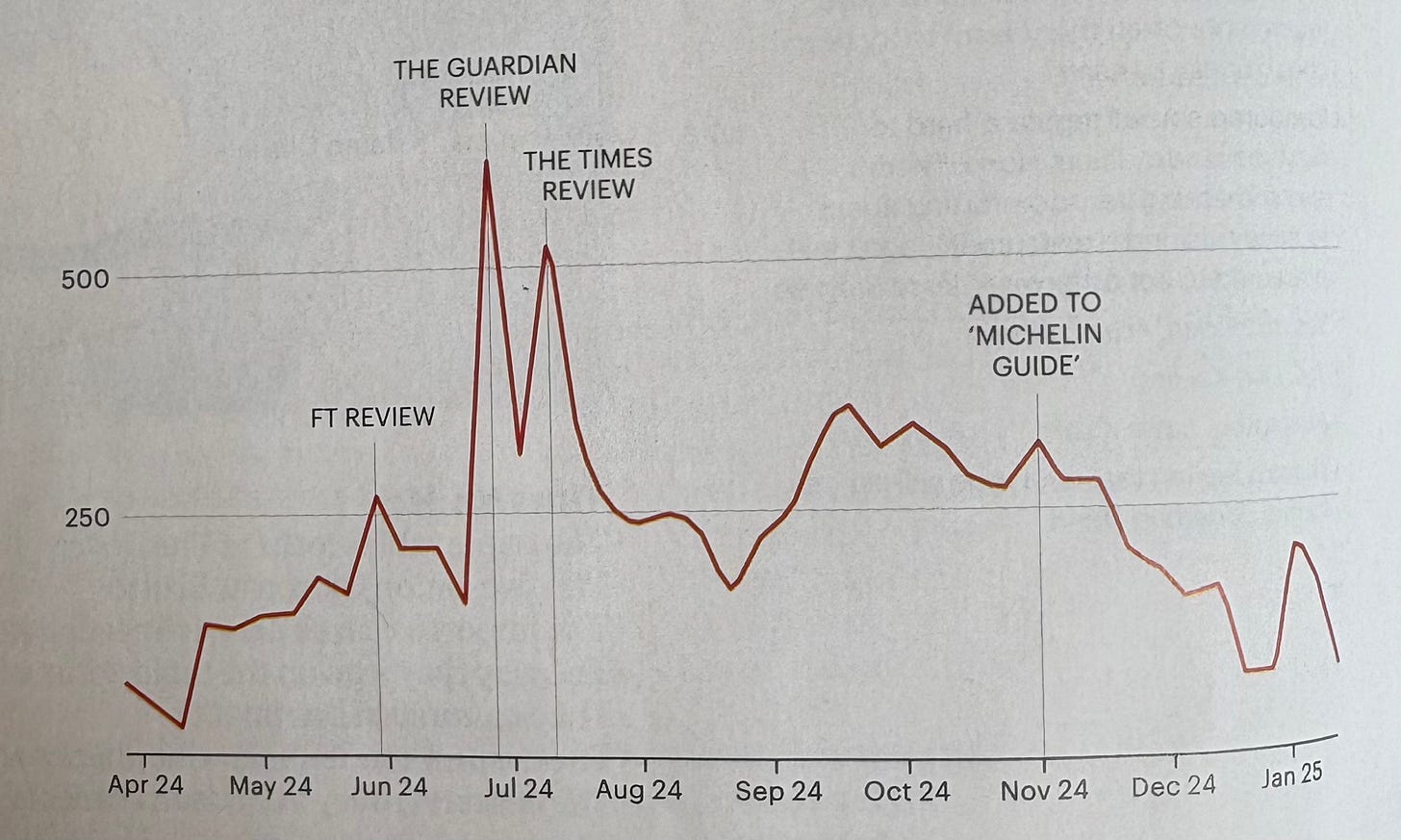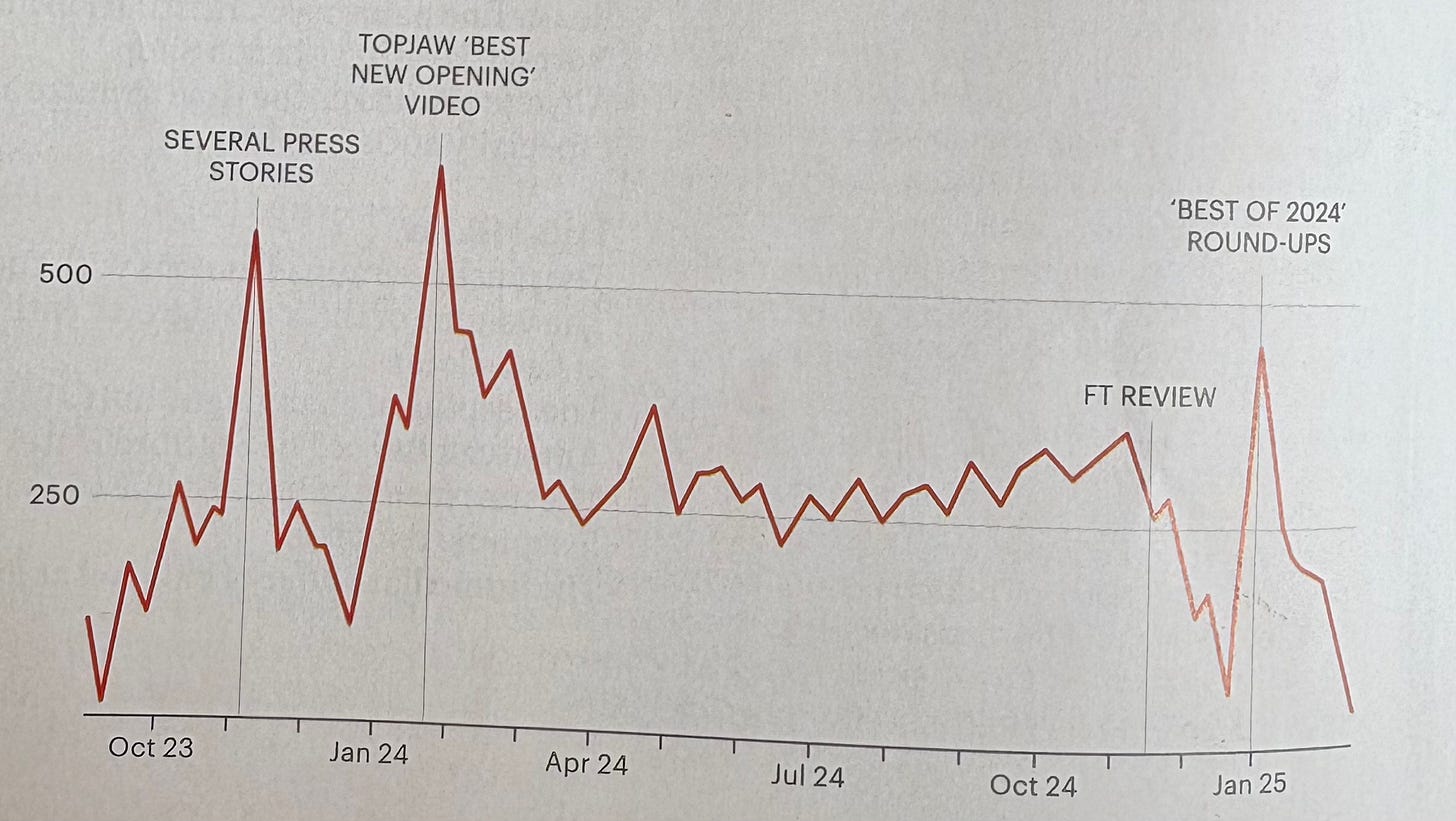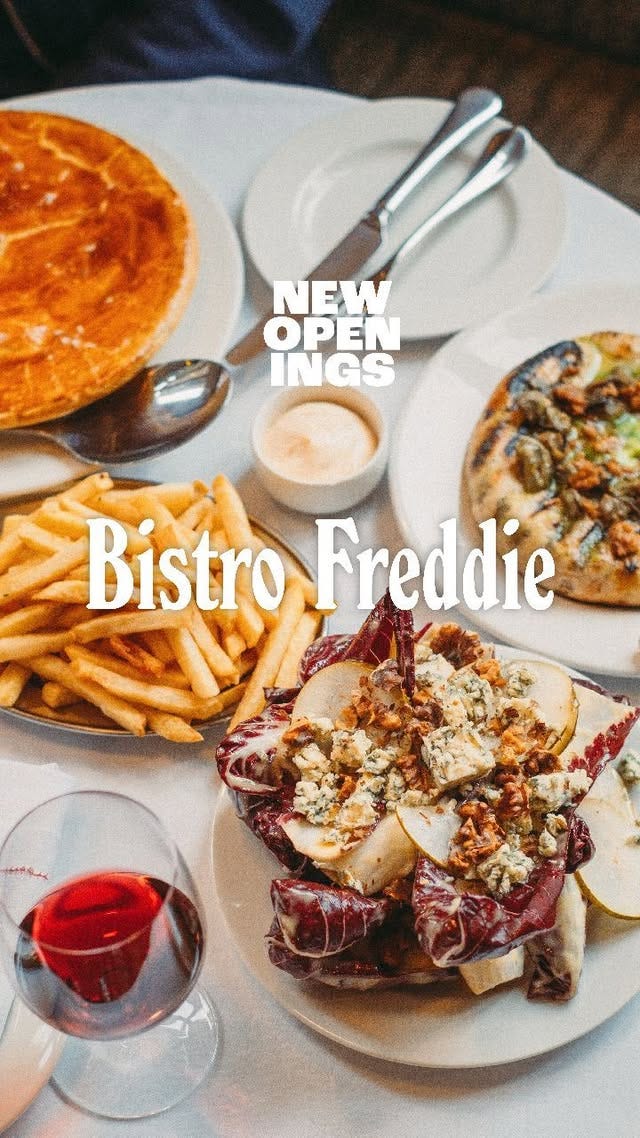Deliciously Digital: has online restaurant content outpaced newspaper reviews?
PLUS: IS THE "WOKE" SNOW WHITE REALLY A BOX OFFICE BOMB?!
The efficacy of digital marketing techniques is often hard to measure. When a podcast or YouTube video or news article goes “viral” (as the kids are saying), is that a result of a specific amplifying event, such as a celebrity Instagramming about it? Or is it a function of internal algorithmic excitement? Could it even just be the semi-random concatenation of small, positive things? It’s hard to know.
I remember back when I was promoting my two podcast documentary series – The Town That Didn’t Stare and The Town That Knew Too Much – I was plugged into the analytics every day. I wanted to see what made an impact on the overall listening figures and, conversely, what didn’t. That first series, particularly, got quite a lot of press and was reviewed in most of the major UK newspapers, starting with the Financial Times. But it was never clear to me, from the data, that these reviews made any material difference to the overall listening figures. After all, why would they? People might read about the podcast in a newspaper, but the call to action there is slow. Perhaps next time they’re thinking about downloading a new podcast they’ll try mine, but there is an accepted wait time between reading a review and purchasing a product. When you read a review of a new film release, you tend not to rush straight out to the cinema; people who read my television reviews are unlikely to do so while browsing the Netflix menu. And so on.
The one press event where I could see a really tangible spike in listens was when the Daily Mail ran a midweek double-spread feature based off the podcast. Boom, that quadrupled listeners overnight. Similarly, another project I’ve been working on over the past couple of years, Movers & Shakers, received a huge amount of press attention. But whether it was BBC Breakfast or The Telegraph’s money column, it was hard to discern a clear pattern amid the press flurry. And then the show was featured on the cover of The Observer magazine, and, finally, I could see that big, pronounced spike. Both of these instances made something clear to me: if print journalism is going to have an impact on podcast listenership, it has to stand on its own two feet as a demonstration of the subject matter. Reviews can only take you so far – better to seduce people with the intrigue of your topic (whether that’s West Sussex cults or, er, Parkinson’s disease) and hope that they’re sufficiently enticed.
But generally, these few self-reported instances aside, it can be hard to find data on the impact that media and marketing have. So I was delighted to see the Financial Times weekend magazine produce a really fascinating case study last Saturday (and compliments, here, to their data journalist
). In the piece, she extracted bookings data from four restaurants (Cloth, Bistro Freddie, Chishuru, and Gloriosa) and plotted them over a relatively similar time horizon (the longest, 2020-present; the shortest, April 2024-present). The point was to look at the different interventions, and the impacts that they had on bookings data. I want to pick out two of these. The first case study was Cloth, and the comparison made was different newspaper reviews (apologies, in advance, for the crummy photographs I took).Cloth opened on April 29th 2024, so is, in effect, a product launch case study. It’s a prime location in the heart of London’s financial district, so expensive overheads are combined with quite high potential. As the graph demonstrates, within the first 3-4 months of opening, the restaurant received a flurry of newspaper reviews. The FT went first but gave the restaurant a mixed review. The Guardian’s Grace Dent gave the restaurant a better review (not to mention that her opinions are liberated from paywall hell) and The Times’s Giles Coren followed that up with another very positive review. Essentially, the window in which these reviews were being published doubled Cloth’s bookings. And even if it proved only a temporary high, by the autumn of 2024, bookings were consistently around the 250 mark.
Now let’s take a look at this case study from Bistro Freddie, an immaculately well-presented Shoreditch eatery (Shoreditch, for non-Londoners, is very trendy; the Williamsburg of our city, say).
Bistro Freddie’s 2023 opening was met with a significant amount of press attention (though it was not reviewed in a national newspaper until late 2024, when the FT gave it a fairly downbeat appraisal). Small matter, because the press attention in the months after opening was positive, even if it wasn’t from the traditional gatekeepers of taste. And then in January 2024, Topjaw, an insurgent Instagram channel rapidly becoming a key player in London’s restaurant PR scene, featured Bistro Freddie. Topjaw is a pretty simple proposition: a well-coiffed and enthusiastic host interviews chefs, restauranteurs and critics about the best restaurants in town. From that, the duo (host Jesse and cameraman Will, who has also become Kate Middleton’s favourite videographer) have created a mini-empire of succulently shot food and restaurant content. Their ‘best opening’ video about Bistro Freddie more than doubled the restaurant’s bookings, a similar impact to Grace Dent’s glowing review of Cloth.
Their Bistro Freddie review has 10.4k likes and 5,400 comments. This is pretty much par for a Topjaw video of that period (there has been a slight deflationary process in the year since, as they’ve increased their output and more imitators have emerged). But that level of engagement on Instagram has had a material conversion to IRL bookings in Shoreditch. Murray’s analysis (and interviews with the proprietors) draws a clear difference between these two openings: Cloth is old-school, in a less fashionable part of town and appealing to an older, more well-heeled clientele; Bistro Freddie is all glitz and glamour, designed for yuppies who want to photograph their ox-cheek-and-Guinness pie. One is a neater fit for a national newspaper review, the other better suited to the salivating Insta-crowd.
It’s rare to see graphs laid out like this, showing the impact that single events can have on customers. Restaurants live and die on discoverability and they are big-ticket, low-margin entertainment products (very much at the opposite end of the spectrum to podcasts). All the same, the PR consequences of this data seem clear. This is all about narrative.
Cloth opens in the City, and it struggles to fill its dining room. This is natural: this is an area where bankers have been eating the same gouty feasts for years, and might not be instinctively drawn to change. But Cloth doesn’t need to go direct to consumers (or, at the very least, the consumers who’ll be consuming their Angus Ribeye), they need to get into the PAs market. Direct-to-secretary, so to speak. To do that, they need to i) make sure that people know they exist, and ii) cultivate a perception of quality and sophistication. Within about a week they get the perfect one-two punch. The Guardian (Britain’s most-read online newspaper) review confirms the restaurant’s foodie credentials, while The Times (still the bible of Britain’s financier class) codifies its society status. You can now book your boss a table at Cloth, the narrative has been set.
For Bistro Freddie, the necessary narrative is different. They are marketing direct-to-consumers, and their client base are likely to be more price sensitive. Generally, they will be social diners rather than business ones. Which means you need to create a narrative of exception. “Substance as well as style,” as Topjaw tells us. You are competing here for the attention of people who’ll go for a ‘nice meal out’ once a fortnight or so, and so you have to grab them. A zeitgeisty name, gimmicks (handwritten menus, for instance), and food that makes them instantly hungry. And however brilliant Tim Harford and Grace Dent and Giles Coren might be at delivering persuasive verdicts on the capital’s latest hotspots, I’m never going to drool over the newspaper in quite the same way as I do over a punchy 1-minute Instagram reel. When you’re selling to ravenous punters, you need to trigger that salivary gland; when you’re selling to someone’s secretary, you’ve got to convince them their boss isn’t going to be disappointed.
Narrative matters in how we build all our digital products. It should shape the marketing plans you build for anything that requires seducing an audience. Who are the people who will enjoy your show? When will they listen? Why will they listen? How will they listen? Are they the desired point of contact, or a vector for other potential listeners? Are we trying to complement their existing consumption habits, or replace them? Is this a show for people who are already engaged with – obsessed by, even – the subject matter, or are we trying to invite the uninitiated into proceedings? Do people care that the show is ‘good’ or would they prefer to be told that it’s ‘popular’ or ‘interesting’ or ‘controversial’?
These are the questions we have to ask. As the piece in the FT proves, there is a clear bifurcation in the industry between legacy coverage and new media coverage. Both have their place, both can generate the impact that creators desire. But to expect them to have the same consequences for radically differing projects would be wilfully blind to the necessity of creating a pathway for potential consumers.
Below the line – for my favourite people: paying subscribers – a note on Snow White and whether woke cinema is really getting punished at the Box Office.
Keep reading with a 7-day free trial
Subscribe to Future Proof to keep reading this post and get 7 days of free access to the full post archives.







